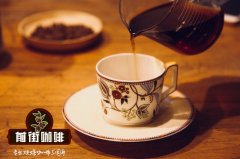Costa Rican Tarazu La Pira Estate Pila Manor Tibica seed washing treatment

Professional coffee knowledge exchange more coffee bean information please follow the coffee workshop (Wechat official account cafe_style)
Tara bead, Costa Rica | what is the flavor of Tibica washing treatment in La Pira Estate Pila Manor?
Named after the nickname PIRO of Gilberto Urena, the father of Carlos Carlos, Pilar Manor has a history of 50 years. After inheriting the family farm, Carlos operated as an organic certified coffee farm, but because of the high cost, Carlos chose another type of manor care in recent years. He raised animals such as goats and ate weeds on the manor. Directly reduced the use of chemical or organic herbicides, among other economic values, the feces also contribute to the fertilization of coffee trees. Make the coffee in the manor clean and sweet. Located in the Dota Valley, the estate features a changeable climate and provides an ideal temperature for coffee beans to grow.
Pilar Manor won the COE in 2009, 2011 and 2012, and won the third place in C.O.E with a high score of 88.85 in 2011.
The seven main coffee producing areas in Costa Rica are distributed along the inland central plateau from northwest to southeast. Costa Rican volcanic terrain with fertile volcanic ash, mild and suitable temperature, and stable and abundant rainfall is one of the reasons why coffee has become one of the main agricultural products in Costa Rica. As the coffee industry in Costa Rica began to develop since the middle of the 18th century, it was the first country where coffee was first introduced into Central America and has a long history, so the coffee organization has a complete system from production to marketing. In terms of quality and quantity, Costa Rican coffee has always been recognized by the world, and has been rated as the world-class high-quality coffee.
Coffee began to appear in Costa Rica in 1729, when it was introduced from Cuba. This made Costa Rica the first country in Central America to grow coffee and the first to grow coffee because of its commercial value. Then, after Costa Rica became independent from Spain in 1821, the local government began to support the coffee industry with a series of policies. At that time, it was more than a hundred years after coffee was introduced into Costa Rica, but about 70,000 coffee trees have been planted, which shows the speed of its development. The local government's policies on the coffee industry include:
In 1825, the Costa Rican government implemented a tax exemption policy. In 1832, the local government promulgated a law that "there is land for growing coffee", meaning that coffee farmers can own the land directly if they grow coffee on any land that is not occupied. As soon as this example comes out, it encourages many people to grow coffee and promote the development of coffee. (it can also indirectly explain why most of Costa Rican coffee comes from private estates.)
It is conceivable that when there are more products, the quality will become different, affecting competitiveness. So in order to improve the quality and value of coffee, at the beginning of the 20th century, the government enacted legislation that coffee farms or plantations in Costa Rica could only grow coffee from Arabica, so as to enhance their competitiveness. This helps to understand why Costa Rican coffee is now so superior: coffee from Costa Rica is all Arabica, and we can never find Robusta.
Subsequently, in 1948, the Costa Rican government established an exclusive coffee department (that is, the Costa Rican coffee industry company ICAFE:Institutodel Caf é de Costa Rica. It has been taken over by the official Coffee Committee Oficinadel Caf é), mainly coaching the manor from planting, post-processing to the improvement of the sales system. The place is also very careful in handling coffee for export. Among the exported coffee, coffee beans that are considered to be of substandard quality will be colored by blue plant dyes and then returned to China for sale. Today, about 1/3 of Costa Rica's population is engaged in coffee or coffee-related industries, and per capita coffee consumption is twice that of Italy or the United States. From various policies, we can see that the government's support for the coffee industry has indirectly made Costa Rica's coffee better and more competitive than other countries.
Flavor description: dry aroma with citrus, lemon, roasted almond slices, with a touch of fine floral aromas. The entrance is fresh lemon green tea, citrus, kiwi fruit, honey grapefruit tea, sweet blueberry, strawberry aroma, taffy tail. There is a delicate fragrance of flowers at high temperature, and the smell of Moli flowers is obvious after cooling.
Up to now, Costa Rica's coffee industry is one of the well-organized industries in the world, with a yield of 1700 kilograms per hectare. With a population of 3.5 million, the country has as many as 400m coffee trees, and coffee exports account for 25 per cent of total exports. In Costa Rica, where coffee is produced, coffee of all grades and types also accounts for 1/3 of global consumption. Thus it can be seen that the quality of her coffee gives her a place in the global coffee market, and being loved by people, the history of the development of the coffee industry cannot be ignored.
Producing area: Tarazhu
Grade: SHB
Altitude: 1650 m
Variety: Typica
Treatment: washing
Qianjie recommended cooking:
Filter cup: Hario V60
Water temperature: 90 degrees
Degree of grinding: small Fuji 3.5
Cooking methods: the ratio of water to powder is 1:15, 15g powder, the first injection of 25g water, 25 s steaming, the second injection to 120g water cut off, waiting for the powder bed water to half and then water injection, slow water injection until 225g water, extraction time about 2:00
Analysis: using three-stage brewing to clarify the flavor of the front, middle and back of the coffee. Because the V60 has many ribs and the drainage speed is fast, it can prolong the extraction time when the water is cut off.
Important Notice :
前街咖啡 FrontStreet Coffee has moved to new addredd:
FrontStreet Coffee Address: 315,Donghua East Road,GuangZhou
Tel:020 38364473
- Prev

The western valley of Costa Rica? the flavor of Kaduai red honey treatment at the Hills of St. Louis?
Professional coffee knowledge exchange more coffee bean information please follow the coffee workshop (Wechat official account cafe_style) Costa Rica western valley | St. Louis Hill Manor Kaduai red honey treated flavor? The seven main coffee producing areas in Costa Rica are distributed along the inland central plateau from northwest to southeast. The Costa Rican volcanic terrain is rich in volcanic ash, mild and suitable.
- Next

Tanzania Mbozi Province| Ilomba Village Ilomba Washing Plant Kent kents flavor?
Professional coffee knowledge exchange More coffee bean information Please pay attention to coffee workshop (Weixin Official Accounts cafe_style) Tanzania Mbeya production area| Ilomba Village Ilomba Washing Plant Kent kents flavor? Ilomba washing plant is located in Ilomba village, Mbozi province, Tanzania, southwest of the country on the steep slopes of Mbeya highlands, Ilomba Ilomb
Related
- Detailed explanation of Jadeite planting Land in Panamanian Jadeite Manor introduction to the grading system of Jadeite competitive bidding, Red bid, Green bid and Rose Summer
- Story of Coffee planting in Brenka region of Costa Rica Stonehenge Manor anaerobic heavy honey treatment of flavor mouth
- What's on the barrel of Blue Mountain Coffee beans?
- Can American coffee also pull flowers? How to use hot American style to pull out a good-looking pattern?
- Can you make a cold extract with coffee beans? What is the right proportion for cold-extracted coffee formula?
- Indonesian PWN Gold Mandrine Coffee Origin Features Flavor How to Chong? Mandolin coffee is American.
- A brief introduction to the flavor characteristics of Brazilian yellow bourbon coffee beans
- What is the effect of different water quality on the flavor of cold-extracted coffee? What kind of water is best for brewing coffee?
- Why do you think of Rose Summer whenever you mention Panamanian coffee?
- Introduction to the characteristics of authentic blue mountain coffee bean producing areas? What is the CIB Coffee Authority in Jamaica?

